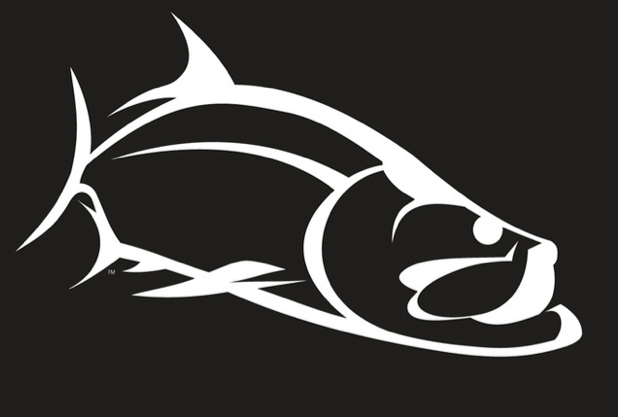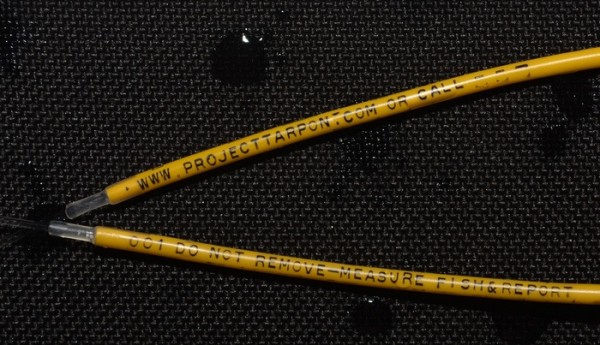Tarpon tracking and research with conventional streamer tags. Initial distribution of 2,000 streamer tags to be placed in tarpon and create a website for reporting and publishing recapture data.
by Project Tarpon, LLC
About this project
What are the goals and objectives of this research effort?
Our goal is to fund the production and deployment of at least 2,000 custom made fish tags uniquely designed to assist marine biologists in the research of Atlantic tarpon (Megalops atlanticus) movements, migrations and population dynamics. To achieve this goal, our objective is to place the 2,000 harmless tags in tarpon during the spring, summer and fall of 2015 while they move through U.S. coastal waters. By providing a large number of tags at no cost to select professional fishing captains, and also making these tags available to private anglers through this initial fund raising effort, we hope that in a single year we can release enough tagged tarpon to immediately begin generating valuable recapture data and tracks of tarpon migrations. By funding this effort, you’ll not only get to participate, but you will also help us place almost a thousand tags in the hands of select professional fishing guides, ensuring that we get a large number of tarpon tagged the first year … and it is, of course, all about the numbers.
What is a tarpon and why are tarpon important?
While tarpon have existed as a species for more than 100 million years, we are only now beginning to get a glimpse into their life history, ocean migrations and population abundance. Although tarpon can live for more than seventy years and often grow in excess of two hundred pounds, they are not generally considered an edible fish in the U.S., but are the focus of consumption in artisanal and subsistence fisheries in Latin America. The level of connection of our fisheries is therefore a vexing question. In the U.S., tarpon are mostly sought only by sport anglers. Outdoor Life Magazine writer Jerry Gibbs once commented about tarpon, “They jump, they crash, they break tackle and bones. Tarpon possess the muscle and mass to defeat you in several different ways. Of course, that is why we love them … !” It is no coincidence that anglers around the world refer to tarpon, with their iridescent silver-scaled bodies, as the “Silver King”. Tarpon fishing annually generates billions of dollars in local revenues for communities around the country. So as a sport fish, they are vital to the livelihood of many families. Just as important, however, marine biologists are beginning to believe that detailed information about tarpon migratory patterns may prove that tarpon are the canaries of the coastal ocean. Large migratory tarpon annually frequent deep offshore waters, where oil and gas drilling takes place, as well as small streams and estuaries subject to pollution, excessive freshwater use, and human encroachment. Consequently, by attempting to track their movements and behaviors, we are offered a window not only into the life of this magnificent game fish, but man’s impact on our planet.
Back this project!
Why is this research important now?
Due to their long lives and thousand mile migrations, tarpon are influenced by many different environmental and man-made factors. Without coming to a better understanding of their behaviors and man’s influence on this species, we can’t hope to protect and sustain them for generations to come. In some locations, such as Texas, tarpon populations have crashed precipitously over the past fifty years. In the early part of the twentieth century, Port Aransas, Texas, was considered the “tarpon capital of the world”. By 1970, that had all changed. The tarpon were gone. Over-harvesting in Mexico during winter migrations, bad fishing practices, and the placement of dams on Texas rivers all hastened the decline. If we don’t learn all that we can now, there is no way to understand and mitigate man’s potentially negative future impacts on tarpon in areas like Florida, where tarpon are still considered abundant.
Who is Project Tarpon?
Project Tarpon, LLC was formed in 2010 with one simple goal in mind, bring tarpon anglers and marine biologists together to share resources and information about tarpon. In the process, we hoped to make tarpon anglers better fishermen and provide critically needed resources to marine biologists and graduate students looking for assistance with their research. To facilitate this synergy between sport fishermen and scientists, Project Tarpon launched ProjectTarpon.com. By providing, among other things, scientific research data, links to weather forecasting and a forums pages, www.projecttarpon.com has proudly fulfilled its mission of being the place “where angling and science meet.” In the past five years, Project Tarpon has primarily focused its research efforts on placing satellite tracking tags in tarpon. ProjectTarpon.com personnel have been instrumental in bringing together interested anglers and scientists to assist in the placement of satellite tracking tags. Once the data started to roll in, ProjectTarpon.com worked closely with fisheries scientists at the University of Miami’s Tarpon & Bonefish Research Center (www.tarponresearch.com) to provide migration maps, charts and detailed information concerning the tagged tarpon. But anglers need not worry, we’ve done all this without giving away any secret fishing locations.
Back this project!
Why streamer tags, what are they and how do they work?
Satellite tracking tags are too expensive, complicated and difficult to place for most anglers. This is the realm of competent scientists. Consequently, a lower-tech, simpler and easier alternative is necessary for recreational anglers to actively participate in tarpon tracking research. Streamer tags offer that alternative. Streamer tags have been proven through significant scientific study not to harm fish and last for years. They are the perfect cost-effective compliment to satellite tracking tags. They are implanted just below the skin and do not cause any lasting injury to the tarpon. Our streamer tags will use a metal dart and a nylon streamer, marked with a unique tag number and contact information for reporting a catch.
Streamer tags are easy to place on the tarpon with very little instruction, thereby allowing more participation by the average anglers.
How do these tags help us learn about tarpon?
The things we can learn from tags in addition to movements from the location of capture are the environment where the recapture took place (e.g. offshore, coastal estuary or river), overall health of the fish, including growth rates since original release, and population abundance. All of this information is important to learning more about the population dynamics of tarpon and sustaining the fishery.
Why are so many tags necessary?
Prior studies with other tagging mechanisms have shown that tarpon recapture rates are around 1%. So out of 2,000 initial tags to be funded and placed, there will be approximately 20 recaptures. The more tags placed, the more we can learn and the more reliable the information. This is why once the initial tag funding has taken place, ProjectTarpon.com will continue to offer more tags and more tagging packages to anglers in the future.
Where will I be able to find the information about recaptured tags?
This is where the cool part of this process will come into play. We have developed a web portal at www.tarpontags.com for anglers to report tarpon that they have tagged and released, as well as any information on tagged tarpon that have been recaptured. Once the angler enters the data, it will be accessed directly by the marine biologists at the University of Miami. The level of detail concerning the tag or recapture location is up to the angler, so no secret spots need be revealed. Anglers just need to remember, the more specificity the information given, the more meaningful it will be to the scientists. Once recaptures start to take place, we will post the recapture data on the website for all interested anglers to view.
Who will see the information on where I tag a fish or recapture one?
The last thing we want to do is to reveal anybody’s fishing spot. The form that you will be able to fill out on-line will have blanks where you can be as detailed as you want or as vague as you want. In other words, you can give us Lat/Lon numbers if you wish, or just simply say something like “Upper Charlotte Harbor” or “Galveston Beachfront” or “West Delta, Louisiana”. This information will go directly into a data base maintained by the biologists. We may periodically issue reports like “Ten tags placed in June in Tampa Bay by ________” or “Eleven tags placed in the last week in West Delta Louisiana by ______”. You don’t even have to submit the information in real-time. Write it down, then input the data at your convenience. When we get a recapture, we’ll let you know where it was tagged, e.g. “Fish #____ was tagged by ______ in Boca Grande on June 1, 2015, and recaptured by ________ in West Delta, Louisiana on September 3, 2017.” We’ll also give details on how far that fish has traveled, if the fish has grown and by how much, and even an approximate age of the fish.
After my initial order, can I order more tags?
Absolutely! After our initial order and production of tags, we will maintain an inventory of tags and tag sticks to provide anglers in the future. So, if you participate in the initial tag release and want more tags, you’ll be able to order them from the Project Tarpon and tarpontags.com websites.
About Project Tarpon:
Project Tarpon, LLC was created in 2010 by Scott Alford, an avid angler who has traveled throughout the Western Hemisphere in pursuit of tarpon. Being an accomplished tarpon tournament winner, tournament director and active participant in tarpon conservation, Scott created www.ProjectTarpon.com to be a one-stop source for interested tarpon anglers. Project Tarpon’s goal has been to create a community of anglers and marine biologists to participate in tarpon research. Having personally worked with marine biologist for more than ten years and coordinated the placement of satellite tracking tags in tarpon from the jungles of Nicaragua to the coasts of Texas and Florida, Scott saw a need to link biologists and anglers so both could learn more about these magnificent game fish. He has successfully used Project Tarpon’s website to make the information and data gathered by these biologists available to the general angling public. ProjectTarpon.com is truly “where angling and science meet.”








